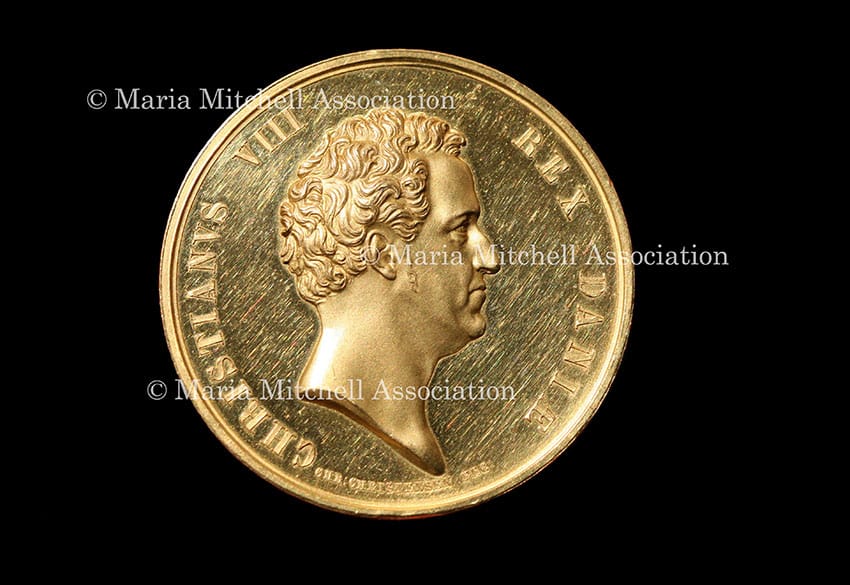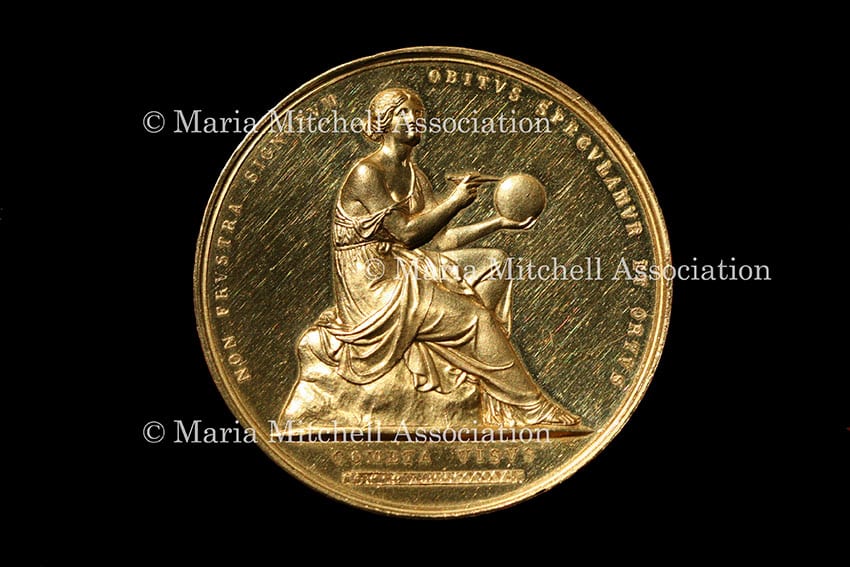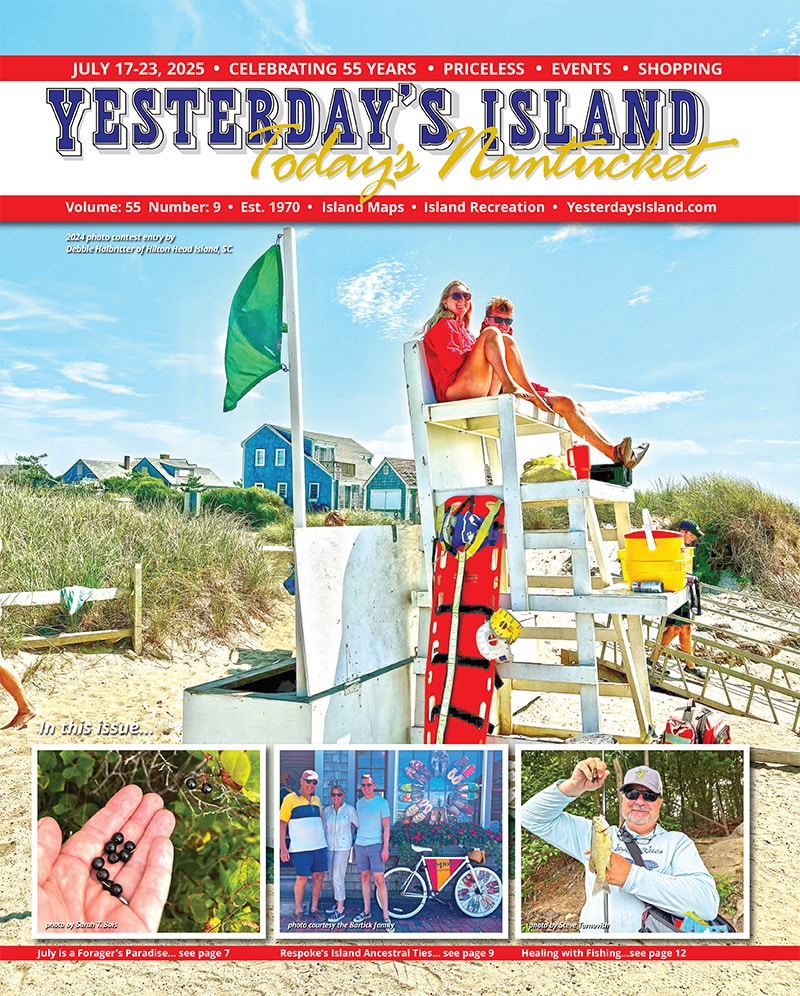~ by Katherine Brooks with MMA Curator & Deputy Director Jascin Leonardo Finger ~
“A blazing and fiery comet flashes upon us… it is not strange that a slight shudder comes to even an intelligent observer. For how much do we know of them?” –Maria Mitchell
This coin is actually too big to flip; it is a solid gold medal presented to Maria Mitchell in 1848 for her discovery of Mitchell’s Comet in 1847. One side of the medal presents a portrait of the King of Denmark while the reverse depicts the Goddess of Urania, muse of astronomy. Urania has a globe in her left hand and a stylus in her right. Above her are the words (in Latin) “Not in vain do we watch the setting and rising of the stars,” while above her are the words “Cometa Visus 1st Oct. 1847,” and the outer edge of the medal is engraved with Maria’s name.
At 10:30 p.m. on October 1, 1847 from the roof of Nantucket’s Pacific National Bank, Maria Mitchell spotted a comet (a frozen mass made of rock and ice that orbits the Sun). Located in the sky at “five degrees above Polaris,” this comet made her famous. For a five-day period after the initial sighting, she observed the comet’s motion, only relaying the data to her father, William Mitchell.
Maria was at first hesitant about sharing her discovery – wanting to be “tolerably sure” that it was indeed a comet. Her father finally encouraged her to let him share the information with the Boston Harvard Observatory. Newspapers were soon spreading the word about “Miss Mitchell’s Comet.” Margaret Moore Booker explains in her biography of Maria Mitchell, Among the Stars, the importance of spotting a telescopic comet: “The discovery of a telescopic comet was considered more important than a comet that could be seen by the naked eye because it allowed the astronomer to see a new comet appear earlier in the sky on its way towards the sun.” And that importance was not lost on people in positions of power around the world.
The King of Denmark, Frederic VI, decreed that anyone who discovered a telescopic comet was to be awarded a gold medal. Between Maria’s original hesitancy toward sharing her discovery and cross-continental communication, the gold medal was first presented to Father Francesco de Vico, the director of the Observatory at the Collegio Romano, instead of Maria. Father Francesco de Vico was awarded the gold medal after he spotted and reported the comet on October 3, 1847. But after months of debate and support on behalf of Maria Mitchell from many well-known astronomers in the United States, the committee finally decided to award the gold medal to Maria, who had spotted the comet on October 1.
Maria Mitchell was the first professional female astronomer in the United States, the first woman to receive the gold medal from the King of Denmark, the first American to receive the medal, and the first woman to be elected to the American Academy of Arts and Sciences. At twelve years old, Maria assisted her father, William, by counting the seconds of a solar eclipse from their sitting room on Vestal Street. Maria had always had a curiosity and aptitude for learning and astronomy.
Maria believed in learning-by-doing. She was well read and taught herself celestial mechanics—a study that allows astronomers to calculate the motion of objects in space—higher mathematics, Latin, German, and in later life, Greek! Maria’s love for books, discovery, and astronomy helped her discover the comet that made her famous; she was even hired by the U.S. Nautical Almanac to compute the ephemeris of Venus, which was used as a pseudo “star” for navigational purposes by sailors at sea. Despite her new found attention and fame from her discovery of the comet, Maria remained the librarian of Nantucket’s Atheneum and continued her personal studies and astronomical observations.
The prized medal itself is only brought out to the public once a year—August 1st marks the celebration of Maria’s birthday and the Maria Mitchell Association celebrates with a birthday party along lower Vestal Street which this year includes period music, live falconry demonstrations, astronomy activities, and, of course, the annual opportunity to view Maria’s gold medal.
If you too are intrigued with astronomy and natural science as Maria was, or about the history surrounding the Mitchells, stop by the Maria Mitchell Association for a tour, or celebrate with the MMA staff and interns on August 1 from 1 to 4 pm for Maria Mitchell’s 198th Birthday Party on Vestal Street, just a few steps from the Civil War Monument on Main. This free event is open to all ages.
The MMA was founded in 1902 to preserve the legacy of Maria Mitchell and to promote her belief in learning-by-doing. An astronomer and natural scientist, as well as an educator, Maria Mitchell shot to worldwide fame when she discovered a comet in 1847. For her discovery, she was awarded a gold medal from the King of Denmark – the first American and first woman to receive the honor. She served as the Professor of Astronomy and Mathematics at Vassar College from 1865 until 1888. Today, the MMA operates two observatories, a natural science museum, an aquarium, and the birthplace of Maria Mitchell. The MMA conducts scientific research, leads classes and workshops for people of all ages year-round, and welcomes thousands of visitors to its museums and observatories. For details, visit mariamitchell.org.




